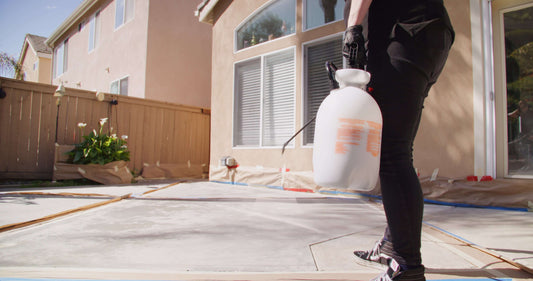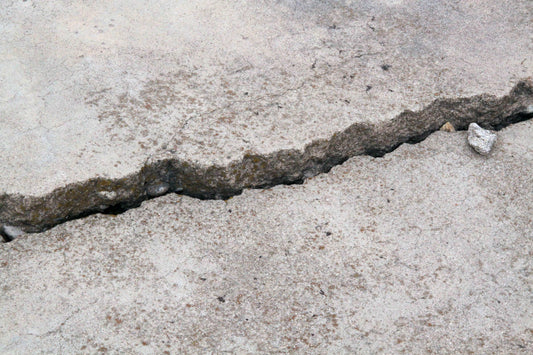Like-Nu Concrete doesn’t offer or sell color for our concrete but our 30 years of commercial concrete services has brought great experience in the coloring concrete world. Here’s our expert tips on using color with Like-Nu Concrete.
Plain concrete doesn't need to be your only choice for a new patio, driveway, or indoor flooring project. Modern concrete coloring techniques give you endless options that match any architectural style or design preference.
Coloring concrete might look intimidating at first. But the right knowledge and techniques let you turn ordinary concrete into stunning, long-lasting surfaces. These surfaces rival natural stone or tile's beauty at a fraction of the cost.
Want to become skilled at concrete coloring or at least add color to Like-Nu Concrete Restoration Kit? Let us walk you through everything - from picking the right coloring method to getting professional results. Your neighbors might think you hired a contractor.
Understanding Concrete Coloring Basics
The simple basics of concrete coloring create endless creative possibilities. We've discovered that concrete takes color through different methods, and each method offers unique advantages for specific projects.
Types of Concrete Coloring Methods
Here are the main ways to color concrete:
- Integral Coloring: Pigments mixed directly into wet concrete before pouring [1]
- Color Hardener: Surface-applied powder that creates a denser, more durable finish [2]
- Stains: Chemical or water-based solutions that penetrate the concrete
- Dyes: Ultra-fine particles that create vibrant colors, primarily for indoor use
How Pigments Work with Concrete
Concrete pigments work as inert additives, typically using metal oxides or carbon-based materials. The dosage ranges between 2% to 8% of the cement content [1]. The color becomes more intense as you add pigment, until it reaches its saturation point [1].
Factors Affecting Color Results
The final color depends on multiple elements. The cement's type is vital - light gray to dark gray cement will affect the final shade [1]. The aggregates make up about 70% of concrete's composition and contribute much to its natural color [1].
Temperature plays a role in color development. Higher curing temperatures lead to finer crystal formation, which makes concrete appear brighter [1]. The water-cement ratio matters too - too much water can make the color lighter than expected [3].
Davis Color products work best with Like-Nu Concrete Restoration Kit. These pigments' color strength helps transfer their natural color to the concrete surface effectively [1]. You can use any coloring product that you feel comfortable with but our experience runs deep with Davis Color. Here is a link to the Davis Color Guide: https://www.daviscolors.com/concrete-colors/ along with FAQs when using Davis: https://www.daviscolors.com/frequently-asked-questions/
Preparing for the Coloring Process
Professional-looking concrete coloring results depend on proper preparation. We have put together a complete guide that will help you succeed in your coloring project.
Essential Tools and Materials
You will need these vital items to get the best results:
- Safety equipment (goggles, respirator, waterproof gloves)
- Garden pump plastic sprayer
- Surface preparation tools
- Cleaning supplies and neutralizers
- Like-Nu Concrete Restoration Kit
- Davis Color products (or a color additive of your choice)
Surface Preparation Requirements
Surface preparation is vital for adhesion and lasting results. We start with a full surface evaluation to check moisture content and contamination. Water beading up on the concrete's surface shows oil or grease that needs removal [5].
The surface needs cleaning with a mild detergent to remove dirt and debris. Any loose or deteriorating concrete must be removed.

Simple Color Application with Like-Nu Concrete Restoration Kit
We recommend reviewing the How to apply instructions of the Like-Nu Concrete Kit before adding color. https://www.likenuconcrete.com/pages/instructions
The base color of Like-Nu Concrete is medium gray. It is the natural color of new concrete.
We are asked all the time if you can add color to the mix? Yes, you can add color to the mix. Simply add the color to the two part mix found in our kit. Mix in the colors really well. If you have a larger job that requires multiple kits, document how much color additive you use to apply to the next mix.
We recommend spraying a sample of your mixed color on a small section and let dry completely (depending on the outdoor temperature - 30 minutes for warm weather) to make sure it is the final color you want.
Working with Like-Nu Concrete is just that simple. That’s why we are known as the most user friendly concrete in the world.
Several popular concrete colors:

Mastering Color Application Techniques For New Concrete Pours
Safety Considerations and Setup
Safety stays our top priority during the coloring process. We always ensure:
- Proper ventilation in the work area
- Use of OSHA-approved respirators for dust protection
- Wearing waterproof boots and protective clothing
- Eye protection with safety goggles [7]
The best working conditions need air and surface temperatures between 50-90 degrees F [8].
Integral Coloring Best Practices
The right measurement of integral colors makes all the difference since these pigments make up only 2-8% of the cement content [9]. Our team adds color to the concrete mix before pouring. We use repulpable bags that completely dissolve during mixing [9]. The water-cement ratio needs to stay consistent throughout the process to get the best results.
Surface Application Methods
The surface coloring process works best with these steps:
- Mix colors really well before application
- Apply in thin, even coats
- Allow proper drying time between layers
- Test colors on a small area first
Color Hardener Application Tips
Color hardeners need extra care during application. The most uniform results come from using 70% of the color on the first pass and the remaining 30% on the second [10]. Timing is a vital factor - our team starts working right after placing the concrete to stay on track with the coloring process [10].
Superior results emerge from using Like-Nu Concrete Restoration Kit with Davis Color products and following these guidelines. Large projects with multiple pours need batch-to-batch consistency. This comes from using identical cement type and aggregate sources [11].
Color hardeners can increase surface strength to over 8,000 PSI in professional-grade stamped concrete. This is almost double the strength of standard concrete [10]. High-traffic areas and projects needing maximum durability benefit greatly from this method.
Ensuring Professional Results
Professional concrete coloring requires meticulous attention to detail and consistent quality control. Experience shows that you need more than simple instructions to achieve outstanding results.
Quality Control Measures
The key to consistent color starts with material control. Our teams use the same cement type and brand throughout each project [11]. Use functioning probes in rock bins, sand bins, and mixer to ensure proper moisture control [12]. Small changes in water content can substantially affect the final color.
Common Mistakes to Avoid
Our experience has revealed several critical mistakes that impact concrete color quality:
- Adding extra water during finishing ("blessing the slab")
- Early or late troweling that causes surface burns
- Using calcium chloride additives that cause discoloration
- Inconsistent mixing times between batches
- Improper curing methods that trap moisture [13]
Troubleshooting Color Issues in new cement pours
Here's what we recommend for blotchy or inconsistent colors:
- Surface Cleaning: Remove any efflorescence with mild detergent first [14]
- Color Enhancement: Apply color-matched wax treatment to even out color variations [11]
- Moisture Control: Check surface moisture before applying treatments [15]
The best results come from keeping pigment addition rates between 1% and 5% of cement weight [12]. This will give a proper color development without compromising concrete strength. Color assessment should wait 90 to 120 days to ensure accurate evaluation [3].
Get Started Today
Beautiful colored concrete projects just need careful attention, good preparation, and quality products to look professional. You can turn plain concrete into stunning architectural features with different coloring methods - from integral pigments to surface applications.
Getting great results depends on using the right techniques and steering clear of mistakes. Anyone can create professional-grade colored concrete finishes that last with proper surface prep, correct mix ratios, and the right safety steps.
Davis Color products combined with Like-Nu Concrete Restoration Kit give you beautiful results whether you're new to this or an experienced contractor. These products deliver excellent color and durability when you follow our guidelines.
The science behind concrete coloring and quality control throughout your project leads to professional results. Temperature, moisture levels, and the right curing process are vital parts to get your desired color.
Want to start your concrete coloring project? Purchase a Like-Nu Concrete Restoration Kit today to reshape the scene of your concrete surfaces into beautiful, lasting finishes that will improve your property's value and curb appeal.
References
[1] - https://www.bft-international.com/en/artikel/bft_Influencing_factors_for_the_successful_coloring_of_concrete-3544703.html
[2] - https://www.solomoncolors.com/blog/concrete-color/hardener-vs-integral.html
[3] - https://folsomreadymix.com/2017/11/28/common-issues-of-discoloration-in-colored-concrete-and-how-to-avoid-them/
[4] - https://www.collomix.com/en-us/mixpertise/how-to-color-concrete
[5] - https://www.thomasindcoatings.com/four-essential-steps-for-concrete-surface-preparation/
[6] - https://usa.sika.com/en/construction/floor-wall/resource-center/guides/surface-prep-guide.html
[7] - https://sharkepoxy.ca/concrete-coatings-the-guide-to-safety-precautions/
[8] - https://www.behr.com/consumer/how-to/floor-coating/prep-of-coated-concrete-for-paints-and-stains
[9] - https://www.brickform.com/product-category/integral-color-for-concrete/
[10] - https://www.forconstructionpros.com/concrete/decorative/colors-stains/article/22879794/decocrete-supply-how-to-get-started-with-color-hardener
[11] - https://www.concretedecor.net/departments/concrete-placing/seven-tips-for-installing-consistent-integral-color/
[12] - https://www.dynamiccolorsolutions.com/s/DCS-Inc-White-Paper-20-Quality-and-Production-Control-for-Color-Consistency-in-Concrete.pdf
[13] - https://www.anchsand.com/wp-content/uploads/2021/11/ColoredConcreteBestPractices.pdf
[14] - https://jarcosupply.com/blog/78919/troubleshooting-chromixg-integrally-colored-concrete
[15] - https://excelconcretecoatings.com/what-are-the-most-common-mistakes-for-concrete-coatings/




